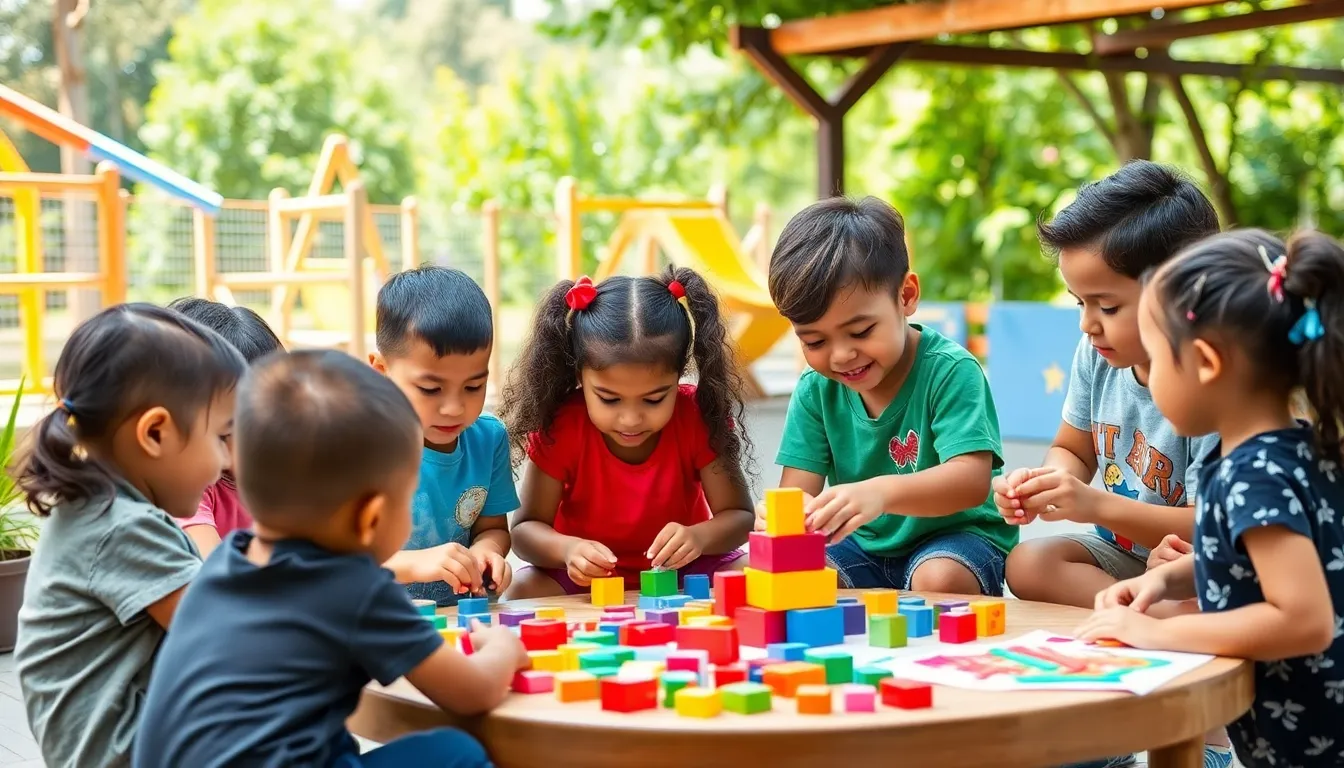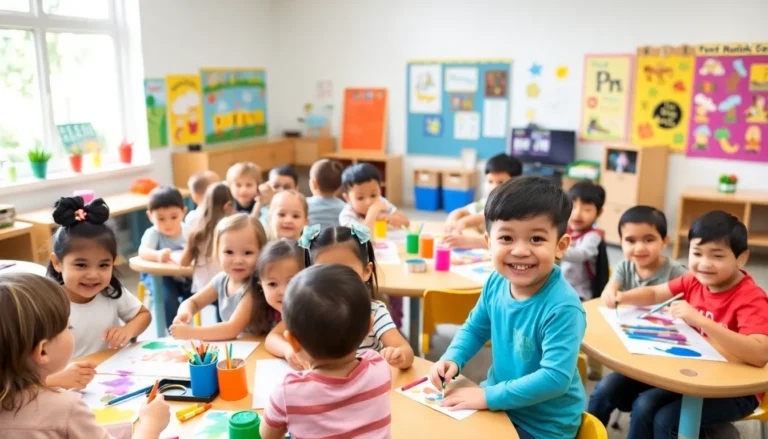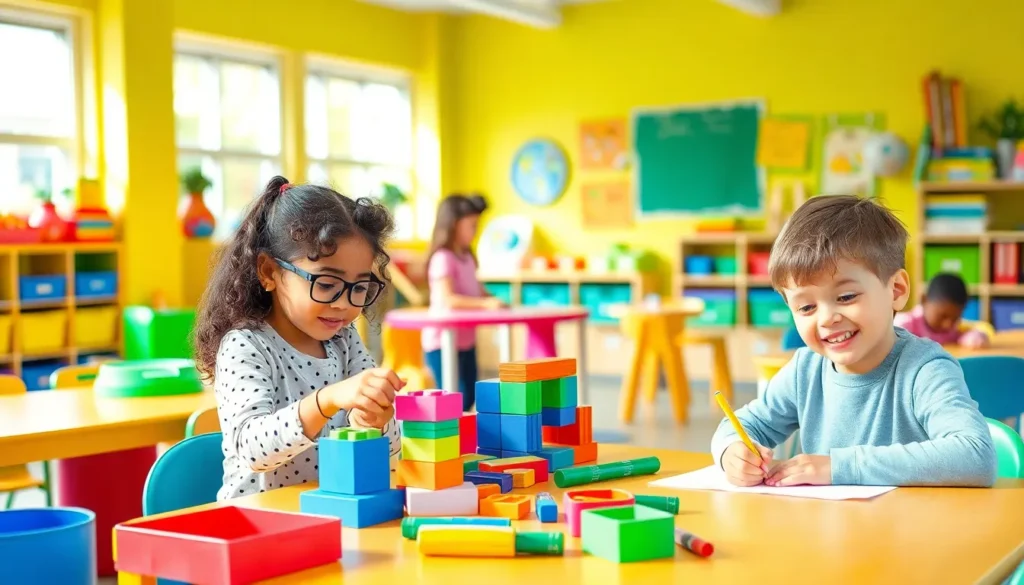Table of Contents
ToggleIn a world where learning often feels like a chore, the play learning environment emerges as a delightful game-changer. Imagine a space where kids can explore, create, and learn without the heavy weight of textbooks. This isn’t just a playground; it’s a vibrant stage where curiosity takes center stage and every corner is an opportunity for discovery.
Research shows that play isn’t just fun and games; it’s a crucial part of effective learning. When children engage in play-based activities, they develop critical thinking skills, social abilities, and even emotional resilience—all while having a blast! So, why not turn the classroom into a wonderland where learning feels like an adventure? Dive into the world of play learning environments and unlock the potential for joyful education that sticks.
Overview of Play Learning Environment
Play learning environments serve as engaging settings where children explore concepts through interactive and immersive experiences. These areas foster both academic and social development by prioritizing fun and dynamic methodologies.
Definition and Importance
A play learning environment emphasizes learning through play. It integrates child-initiated activities with structured guidance from educators. This approach supports cognitive growth, boosts creativity, and strengthens problem-solving skills. Research indicates that children who learn in play-focused settings demonstrate enhanced critical thinking abilities and social interactions. Skills such as resilience and adaptability also flourish in these environments, preparing children for future challenges.
Key Components of Play Learning Environments
Essential elements define play learning environments. Flexible spaces encourage movement and interaction. Diverse materials inspire creativity and exploration, including art supplies, building blocks, and nature-based resources. Collaborative opportunities promote teamwork and communication among peers. Structured routines ensure balance, allowing for both free play and guided learning. Supportive adults play a crucial role, facilitating engagement and providing feedback. Together, these components create a holistic space for learning through play, enhancing children’s overall development.
Benefits of Play Learning Environments

Play learning environments foster numerous advantages for children’s development. These spaces provide opportunities for creativity, exploration, and authentic engagement.
Cognitive Development
Cognitive growth thrives within play learning environments. Children engage with diverse materials, which stimulates critical thinking and problem-solving skills. Play-based activities promote exploration, encouraging curiosity and experimentation. According to research, children experience enhanced memory retention when learning through play due to the emotional connections created. An environment rich in play also aids in developing higher-order thinking skills, as children analyze their surroundings and learn to make connections among concepts. Overall, play learning environments support cognitive abilities, making learning enjoyable and effective.
Social Skills Enhancement
Social skills flourish in play learning environments. Through collaborative activities, children learn to communicate effectively with peers. Interaction during play encourages negotiation and conflict resolution, fostering strong interpersonal skills. Research highlights that children who participate in play-based settings exhibit improved empathy and understanding of others’ perspectives. These environments facilitate teamwork, giving children the opportunity to share ideas and responsibilities. As a result, social interactions become more meaningful, promoting a sense of belonging and community. In essence, play learning environments cultivate essential social skills that shape future relationships.
Designing an Effective Play Learning Environment
Creating an effective play learning environment involves careful consideration of space, layout, and educational materials. These elements work together to maximize children’s learning experiences.
Space and Layout Considerations
Flexible spaces promote movement and exploration. Designers should incorporate areas for quiet reflection and active play. Open layouts facilitate group interactions, encouraging teamwork and collaboration. Incorporating varied zones for different activities helps maintain engagement. Consider using furniture that can be easily rearranged to adapt to various group sizes and learning activities. These adjustments accommodate different learning styles and preferences, providing children with personal ownership over their learning experiences.
Incorporating Educational Materials
Diverse educational materials inspire creativity and critical thinking. Art supplies, building blocks, and sensory items serve to engage children in playful learning. Integrating technology can enhance exploration, allowing children to interact with digital resources. Additionally, the inclusion of books and storytelling materials fosters language development and literacy skills. Ensure that materials align with children’s interests, as this enhances motivation and participation. Regularly updating resources keeps the environment dynamic, inviting ongoing exploration and discovery.
Challenges in Implementing Play Learning Environments
Implementing play learning environments can pose several challenges that require attention and resources. Addressing these issues ensures successful integration into educational settings.
Resource Limitations
Funding constraints often limit the availability of materials needed for effective play learning environments. Schools frequently face budget cuts, restricting access to diverse resources. Teachers may struggle to acquire educational supplies and equipment, hindering their ability to create engaging spaces. Effective play learning environments require investment in flexible furniture, art materials, and technology, which can be costly. Limited resources lead to less stimulating environments, impacting children’s learning experiences. Prioritizing funding for these essential materials increases the chances of successful implementation.
Teacher Training and Support
Training educators to facilitate play learning environments is crucial. Many teachers may lack the experience or knowledge to effectively guide playful learning experiences. Professional development programs focusing on play-based methodologies enhance teachers’ skills and confidence in this area. Ongoing support from experienced staff also contributes to successful implementation. Collaboration with specialists allows educators to share best practices and develop effective strategies for engaging children. Prioritizing teacher training ensures that play learning environments flourish and meet the needs of diverse learners.
Embracing play learning environments can significantly enhance children’s educational experiences. By prioritizing play as a vital component of learning, these environments foster essential skills like critical thinking and social interaction. They create dynamic spaces that encourage exploration and creativity while supporting cognitive growth.
As educators and institutions work to implement these innovative approaches, addressing challenges like resource limitations and teacher training becomes crucial. Investing in both materials and professional development will ensure that play learning environments thrive. Ultimately, reimagining education through play not only benefits children’s academic success but also prepares them for a collaborative and adaptable future.







